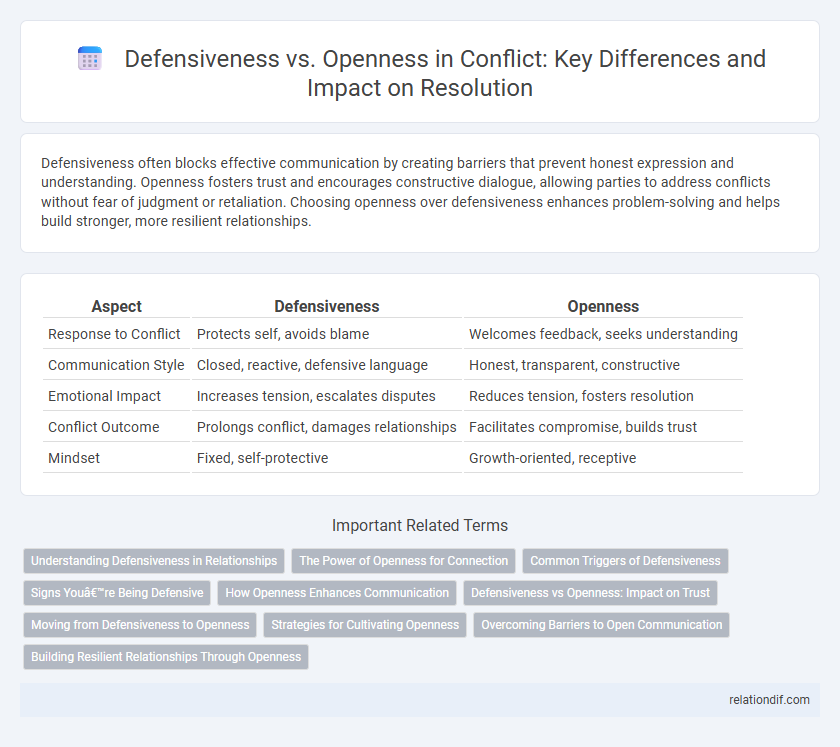Defensiveness often blocks effective communication by creating barriers that prevent honest expression and understanding. Openness fosters trust and encourages constructive dialogue, allowing parties to address conflicts without fear of judgment or retaliation. Choosing openness over defensiveness enhances problem-solving and helps build stronger, more resilient relationships.
Table of Comparison
| Aspect | Defensiveness | Openness |
|---|---|---|
| Response to Conflict | Protects self, avoids blame | Welcomes feedback, seeks understanding |
| Communication Style | Closed, reactive, defensive language | Honest, transparent, constructive |
| Emotional Impact | Increases tension, escalates disputes | Reduces tension, fosters resolution |
| Conflict Outcome | Prolongs conflict, damages relationships | Facilitates compromise, builds trust |
| Mindset | Fixed, self-protective | Growth-oriented, receptive |
Understanding Defensiveness in Relationships
Defensiveness in relationships often arises from perceived threats to self-esteem or emotional safety, triggering protective behaviors that hinder effective communication. Recognizing these defensive patterns enables partners to cultivate openness, fostering empathy and trust that enhance conflict resolution. Emphasizing active listening and vulnerability reduces misunderstandings and promotes a deeper connection amidst disagreements.
The Power of Openness for Connection
Openness fosters trust and mutual understanding, breaking down barriers that defensiveness creates in conflict situations. Embracing vulnerability encourages honest communication, allowing parties to explore underlying issues rather than react impulsively. This power of openness transforms conflicts into opportunities for deeper connection and collaborative resolution.
Common Triggers of Defensiveness
Common triggers of defensiveness include perceived threats to self-esteem, criticism, and feeling misunderstood or unfairly judged. These triggers activate a protective response, often leading to closed communication and escalating conflict. Recognizing and addressing these triggers can foster openness and more constructive dialogue.
Signs You’re Being Defensive
Signs you're being defensive include avoiding eye contact, interrupting others, and justifying your actions excessively. Physical cues such as crossed arms and tense posture also indicate defensiveness during conflict. Recognizing these signs helps shift from defensive behavior to openness, fostering healthier communication.
How Openness Enhances Communication
Openness in conflict fosters transparent communication, allowing parties to express concerns without fear of judgment, which reduces misunderstandings and builds trust. Embracing openness encourages active listening and empathy, enabling a deeper understanding of differing perspectives and facilitating collaborative problem-solving. This approach shifts focus from defensiveness to mutual respect, enhancing emotional intelligence and creating a more constructive dialogue environment.
Defensiveness vs Openness: Impact on Trust
Defensiveness in conflict escalates tensions and erodes trust by triggering defensive responses and blocking effective communication. Openness fosters transparency and vulnerability, which strengthens trust and facilitates mutual understanding between parties. Cultivating openness rather than defensiveness is critical to resolving conflicts and building lasting trust in relationships.
Moving from Defensiveness to Openness
Shifting from defensiveness to openness in conflict encourages active listening and genuine understanding, reducing misunderstandings. Embracing vulnerability fosters trust and collaboration, allowing for productive resolution of disagreements. Practicing empathy and self-awareness promotes a mindset that prioritizes growth over protection.
Strategies for Cultivating Openness
Cultivating openness in conflict situations involves practicing active listening, where individuals genuinely seek to understand the perspectives of others without immediately formulating defenses. Implementing mindfulness techniques enhances emotional regulation, reducing reactive defensiveness and fostering a more receptive mindset. Establishing a safe communication environment encourages honest dialogue and mutual respect, which are essential strategies for transforming defensiveness into openness.
Overcoming Barriers to Open Communication
Overcoming barriers to open communication requires recognizing defensiveness as a natural response to perceived threats during conflicts. Strategies such as active listening, expressing empathy, and fostering a non-judgmental environment help reduce defensive reactions and encourage honest dialogue. Building trust and validating emotions transform interactions, enabling collaborative problem-solving and deeper understanding.
Building Resilient Relationships Through Openness
Building resilient relationships through openness involves embracing vulnerability and active listening to foster trust and mutual understanding. Defensiveness blocks empathy and escalates conflict, while openness encourages collaborative problem-solving and emotional connection. Cultivating transparent communication creates a foundation for long-term conflict resolution and relational growth.
defensiveness vs openness Infographic

 relationdif.com
relationdif.com